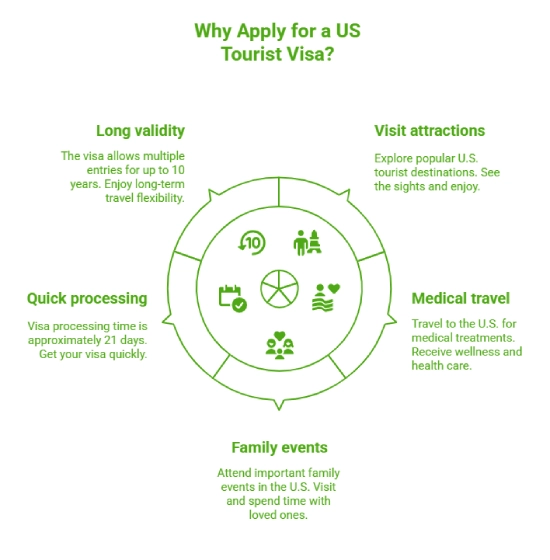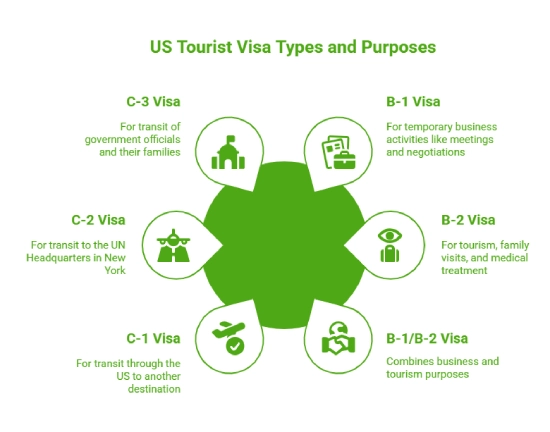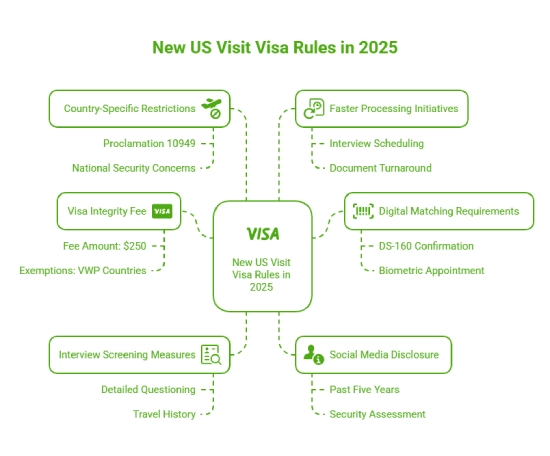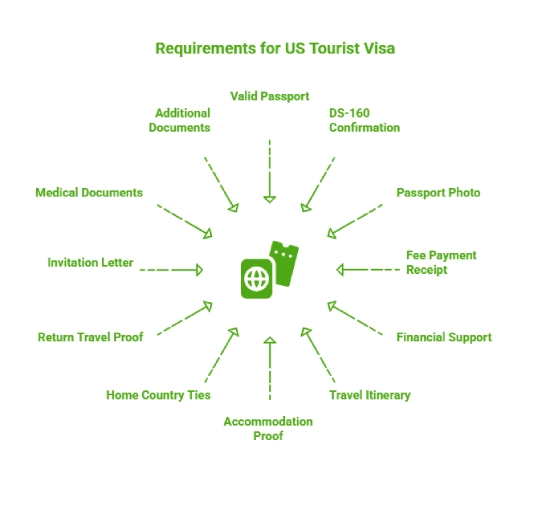
A US Visitor Visa, also known as the B1/B2 visa, is a non-immigrant visa issued to individuals who wish to visit the United States temporarily. It is suitable for:
B1 Visa: Business-related visits (e.g., meetings, conferences).
B2 Visa: Tourism, visiting family or friends, or seeking medical treatment.
The maximum stay allowed per visit is up to 6 months, and visa validity can range from 1 to 10 years, depending on the applicant’s nationality and consular discretion.
*Want to apply for a US tourist visa? Sign up with Y-Axis to guide you with the process.
Thinking of visiting the United States from the UK? The B-2 Tourist Visa makes it possible to explore the U.S., visit family or friends, or even travel for medical reasons. In 2024 alone, nearly 3 million people from the UK visited the U.S., making it one of the most popular destinations for British travellers. With a validity of up to 10 years and the option to stay for as long as 6 months at a time, the B-2 visa offers the flexibility you need for longer holidays or frequent visits.
The United States offers several non-immigrant visitor visas designed for temporary travel. These include separate categories for business, leisure, and transit, each tailored to specific purposes and stay durations.
The table below has details of the different types of US visit visas along with the purpose:
| Visa Type | Purpose Allowed |
| B‑1 | Temporary business activities—such as attending meetings, conferences, negotiating contracts, or consultation visits. |
| B‑2 | Tourism, visiting family/friends, medical treatment, participation in amateur events or short recreational courses. |
| B‑1/B‑2 | Combined business and tourism / medical purposes under one visa. |
| C‑1 | Transit through the U.S. to another destination—allowed airport/airside stay unless landside clearing is granted. |
| C‑2 | Transit visa to reach the UN Headquarters; limited to a 25‑mile radius around New York City |
| C‑3 | Transit for government officials (and their immediate family or staff) passing through the U.S. |

Currently, the United States introduced key updates to its visitor visa policies aimed at enhancing national security, increasing procedural transparency, and improving application processing standards. These changes apply to most non-immigrant visa categories, including B-1/B-2 tourist visas.
Some of the major rules introduced for the US visit visa is as follows:

Some of the benefits of applying for a US visit visa are as follows:
To qualify for a US Visitor Visa, applicants must:
The table below has the list of documents required for a US tourist visa:
| Document | Description |
| Valid Passport | Must have at least 6 months validity |
| DS-160 Confirmation Page | Online form submission confirmation |
| MRV Fee Payment Receipt | Visa fee must be paid prior to appointment |
| Appointment Confirmation | From the US visa scheduling system |
| Photo (Digital + Printed) | As per US visa specifications (white background) |
| Purpose-related Documents | Business invitation, travel itinerary, etc. |
| Proof of Ties | Job letter, property papers, family proof, etc. |
| Financial Evidence | Bank statements, tax returns, payslips, etc. |

You can follow the below steps to apply for a US tourist visa:
Step 1: Fill out the DS-160 form online at ceac.state.gov.
Step 2: Pay the MRV visa fee of $185.
Step 3: Book two appointments:
Step 4: Attend the VAC appointment and visa interview.
Step 5: Submit required documents.
Step 6: Await visa decision and passport return.
| Category | B1 Visa (Business) | B2 Visa (Tourism/Visitor) |
| Primary Purpose | Business activities (meetings, conferences) | Tourism, visiting family/friends, medical visits |
| Eligibility | Business travelers with purpose documents | Tourists or family visitors with valid intent |
| Examples of Activities | Negotiating contracts, attending trade fairs | Sightseeing, family visits, attending events |
| Sponsorship | May be sponsored by employer or self-funded | Typically self-funded or sponsored by family |
| Documentation | Business invitations, meeting schedules | Travel itinerary, hotel bookings, invitation |
| Stay Duration | Typically up to 6 months per visit | Typically up to 6 months per visit |
| Visa Validity | Usually 1–10 years (multiple entry) | Usually 1–10 years (multiple entry) |
| Extension Option | Possible with strong justification | Possible with strong justification |
| Permitted Work | No paid work; only permissible business tasks | No employment or paid activity |
| Interview Requirement | Usually required | Usually required |
| Visa Fee | $185 | $185 |
| Dependents | Must apply separately | Must apply separately |
The table below has details of the US visit visa fees:
| Visa Type | Application Fee (USD) |
| B-1 | $185 |
| B-2 | $185 |
| B-1/B-2 | $185 |
| C-1 | $185 |
The table below has details of the average processing time for the US tourist visa:
| Visa Type | Average Interview Wait Time (Global) | Post-Interview Processing Time | Estimated Total Time (UK Applicants) |
| B-1 | 2–12 weeks (location-dependent) | 3–5 weeks | 6–10 weeks total (London/Belfast) |
| B-2 | 2–12 weeks (location-dependent) | 3–5 weeks | 6–10 weeks total (London/Belfast) |
| B-1/B-2 | 2–12 weeks (location-dependent) | 3–5 weeks | 6–10 weeks total (London/Belfast) |
| C-1 | 2–8 weeks (varies by location) | 3–5 weeks | 5–8 weeks total (London/Belfast) |
U.S. visitor visas, such as the B-1 (business) and B-2 (tourism/medical), are typically issued with long validity periods, allowing multiple entries into the United States. However, while the visa may be valid for several years, each stay in the U.S. is limited to a maximum of 6 months per entry. Visa extensions are possible but must be applied for from within the U.S. before your authorized stay expires.
The table below gives you an overview of the US visit visa validity along with the extension possibilities:
| Visa Type | Typical Validity | Maximum Stay per Visit | Extension Possibility |
| B-1 | Up to 10 years | Up to 6 months | Yes, with USCIS approval |
| B-2 | Up to 10 years | Up to 6 months | Yes, with USCIS approval |
| B-1/B-2 | Up to 10 years | Up to 6 months | Yes, with USCIS approval |
| C-1 (Transit) | Up to 29 days | Transit only (short stay) | No |
Being denied a US visitor visa can be disappointing, but it is not the end of the road. Common reasons for refusal include:
If your visa is refused under Section 214(b) or any other grounds, you can reapply at any time. However, it is strongly recommended to reapply only after addressing the reason for refusal. Ensure you provide updated and stronger evidence, whether it's improved financial status, clarified travel purpose, or new supporting documents.
Y-Axis can assist you with application review, documentation correction, and mock interview sessions to improve your chances of approval upon reapplication.
Yes, family members such as your spouse, children, or parents can accompany you to the United States, but each individual must apply for their own B1/B2 visa. There is no group or family visa under the visitor category each applicant is assessed independently.
Some of the key points to remember include:
Note: All other applicants must attend a consular interview at the nearest US Embassy or Consulate.
As the leading overseas immigration consultancy in the UK, Y-Axis has been providing dedicated immigration assistance to its customers for more than 25 years.
Our team of visa and immigration experts will give end-to-end guidance for all your immigration needs:
Explore What Global Citizens have to say about Y-axis
USA Visit Visa
Y-Axis received a great review from Faiz
Read More...
USA Visit Visa
Y-Axis received a great review from Swat
Read More...
USA Visit Visa
I have been extremely satisfied with the
Read More...
You can follow the below steps to submit your US tourist visa application:
Step 1: Complete the DS-160 form online and print the confirmation page.
Step 2: Pay the US$185 visa fee on the official U.S. visa portal.
Step 3: Schedule your biometric and interview appointments via the US Visa Info site.
Step 4: Attend your biometric appointment at the Visa Application Centre.
Step 5: Go for your visa interview with all required documents.
Step 6: If approved, your passport with visa will be delivered by courier.
To apply for a US B-2 visitor visa from the UK, you typically need:
You can follow the below steps to apply for a US visit visa from the UK:
Step 1: Complete the DS-160 form online and print the confirmation page.
Step 2: Create a profile and pay the visa fee on the U.S. visa portal.
Step 3: Schedule your biometric and interview appointments (London or Belfast).
Step 4: Ensure the DS-160 barcode matches your appointment profile.
Step 5: Attend your biometric appointment at the Visa Application Centre.
Step 6: Go for your visa interview with required documents.
Step 7: If approved, receive your passport with visa by courier.
Yes, you may apply to change status from a B-2 visitor visa to F-1 student status while in the U.S., but only after a minimum stay of 90 days to avoid misrepresentation. Submit Form I-539 along with a student I-20, pay the SEVIS fee, and provide evidence of school acceptance and sufficient funds. Approval depends on eligibility and maintaining legal stay. If not approved, you must depart before the B-2 expires.
The non-refundable application fee for a U.S. tourist visa (B-1, B-2, or B-1/B-2) is US$185, with the same fee for transit (C-1) visas. Some nationalities may also pay a reciprocity (issuance) fee, determined by country and visa type. These fees must be paid prior to scheduling appointments. The Department of State’s fees page provides up-to-date information for all countries.
You should renew your tourist visa if it's expired or has insufficient validity for your planned trips. Many UK applicants qualify for the Interview Waiver Program if renewing within 12–24 months of expiry. If eligible, you can submit a renewal application by mail using the same DS-160 and scheduled process via the UK visa portal, skipping the interview. Always check for current program participation at the time of renewal.
Applicants must fill out the Form DS-160, the Online Non-immigrant Visa Application, via the CEAC website. The DS-160 is required for all temporary U.S. travel, including tourist and fiancé(e) visas. After completing, you must electronically sign the form and print the confirmation page with the barcode number, which is essential for scheduling your biometric and visa interview appointments.
U.S. tourist visa applications can be denied for various reasons, often related to the applicant’s eligibility, documentation, or intent to return.
Some of the major reasons that could cause your US tourist visa to be rejected are as follows:
Yes. While many UK citizens travel to the U.S. visa-free using the ESTA Visa Waiver Program, this applies only to stays of up to 90 days. For longer stays (up to six months), or travel not covered by ESTA, UK nationals must apply for a B-2 visitor visa. This visa allows travel for leisure, medical treatment, or visiting family.
Most UK applicants receive a multiple-entry B-2 visa valid for up to 10 years, permitting stays of up to 6 months per visit, as determined by U.S. Customs and Border Protection at entry. The visa’s overall validity depends on reciprocity arrangements. The DS-160 and reciprocity charts can confirm exact validity periods.
You can follow the below steps to schedule a US tourist visa appointment:
Step 1: Complete the DS-160 form and save the confirmation page.
Step 2: Create an account on the U.S. Visa Appointment Portal.
Step 3: Pay the visa application fee (US$185).
Step 4: Select your VAC and interview appointment dates (London or Belfast).
Step 5: Print your appointment confirmation and take it to your appointments.
As of 2025, the U.S. has introduced several updates to its tourist visa procedures to enhance security, streamline processing, and ensure transparency. Applicants are advised to follow the latest official instructions closely.
Some of the major guidelines for US tourist (B-2) visa applicants:
Note: These guidelines are enforced by the U.S. Department of State and are applicable to all tourist visa applicants, including those applying from the UK.
During the U.S. tourist visa (B-2) interview, consular officers ask questions to assess your travel intent, financial preparedness, and likelihood of returning to your home country. Here are the top 5 commonly asked interview questions:
(Clearly state whether it’s for tourism, visiting family, or medical reasons.)
(Provide specific dates that align with your travel plans and return ticket.)
(Be prepared to present bank statements, payslips, or sponsorship documents.)
(Evidence like employment, property ownership, or family can support this.)
(Honesty is crucial—any past violations can affect your visa decision.)
There is no fixed minimum bank balance required for a US tourist visa. However, applicants should demonstrate that they can fully fund their stay without needing to work in the US. A good benchmark is to show access to £3,000–£5,000 for a short trip. Supporting financial documents such as recent bank statements, income proof, and employment letters can strengthen your application. The key factor is proving that you have sufficient means and a clear purpose of visit.
Yes, you can apply for a US visitor visa without a sponsor. Many applicants travel independently and are self-funded. In such cases, you must provide proof of sufficient personal funds and demonstrate strong ties to your home country, such as stable employment, property ownership, or family responsibilities. However, if a friend or relative in the US is sponsoring your visit, an invitation letter and their financial documents may be submitted to support your application.
Children under the age of 14 may be eligible for a visa interview waiver if applying from the UK, provided they meet certain criteria such as applying for a B-1/B-2 visa and having no prior visa refusals. However, supporting documentation must still be submitted, and a consular officer may request an interview if needed. Parents or guardians may be required to accompany the child for document submission or biometrics, depending on the process at the application centre.